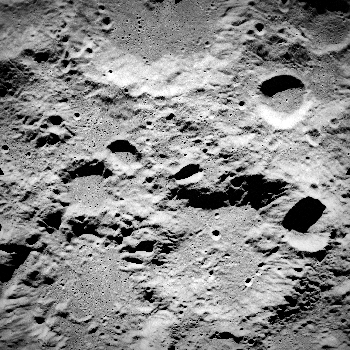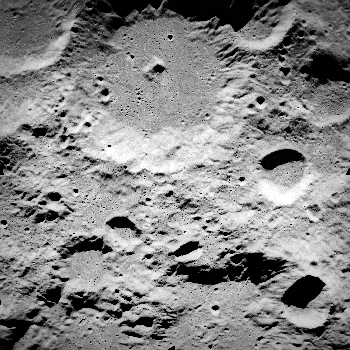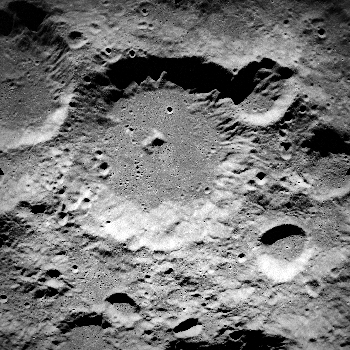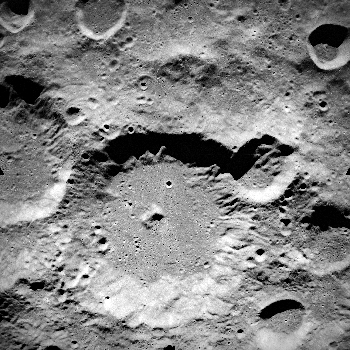
| Project Home | About the Scans | Browse Gallery | Image Map | Support Data | Resources | Ephemeris |
Metric Preview
Below are five digital Apollo 15 metric frames that represent a preview of what is to come in the Apollo Image Archive; a joint project between NASA's Johnson Space Center, Arizona State University, and the Lunar Planetary Institute.
The Apollo Mapping (or Metric) camera flew on three missions, Apollos 15, 16, and 17. It was housed in the Service Module SIM Bay and was commanded to take image sequences, usually in tandem with the Panoramic Camera. An excellent overview on the Apollo imaging systems is available in the NASA publication "Apollo Over the Moon" by Masursky, Colton, and El-Baz (NASA SP 362, 1978).
Each metric frame is scanned using a Leica DSW 700 photogrammetric scanner, which obtains a 200 pix/mm (5 micron pixels) spatial resolution and 14-bit A/D (16,384 shades of grey). The DSW 700 was modfied from the original 12-bit A/D to a 14-bit A/D because the Moon is a very contrasty target and the original film is capable of capturing a very wide range of grey scale variation. The combination of small pixels (5 micron) and the 14-bit gray scale results in a very detailed scan and very large raw scan files (1.3 Gbytes).
To make the images accessible over the Internet to a wide audience, we deployed a web interface that allows the user to rapidly preview each image at high resolution (using the Flash based program Zoomify). We also present several PNG files at decreasing resolution for download in addition to a map projected view and the original RAW scan. Due to the logarithmic response of film to variations in brightness the raw scans appear very contrasty. Photographic paper also has a logarithmic response and in effect reverses the films response, thus a conventional paper print has a natural contrast range. All the processed frames presented here have had a logarithmic correction applied, thus simulating the natural contrast of a conventional paper print; one can think of the processed images as "virtual prints".
For each scan there are 6 download options. The Original raw scan is just that - nothing has been done to those data. They are stored as 16-bit tiff files and are very large (1.3 Gbytes). The processed files have been log corrected (virtual prints) and converted to 8-bit values. The "Large PNG" has been reduced in resolution by the square root of two (1.4142x), the "Medium PNG" by a factor of 2.8x, and the small PNG by a factor of 5.7x. The final two files are map projected versions at 10 m/p (ISIS format and PNG format)
What is the resolution of each image? We can easily calculate the size of a pixel projected on the surface. For instance the frame AS15-M-0081 has a pixel size of 6.2 meters (20.3 feet) at the center of the image in the raw scan. The large PNG file has been reduced by 1.414x, thus its center pixel resolution is 8.8 meters (28.9 ft). But what do these resolutions really mean? A seemingly simple question that is really quite complicated. The angular size of a pixel is important in terms of resolution, but so are other factors. In the case of the Metric films the spatial resolution is limited by the grain of the film and how well the image is exposed. For example in very bright regions the film may saturated thus lowering the effective resolution in that region of the image. Likewise in vary dark regions the image may appear noisy and thus the effective resolution is lower. The focus of the scanner itself also has an effect of the true resolution of the scan. Though the Leica DSW 700 Scanner is of very high quality it is certainly not perfect. Keep in mind that understanding the the true resolution of an image can indeed be complicated.We have scanned the film to capture what we believe is the full spatial
resolution of the film, probably scanning a little beyond
the true resolution of the film. So the large PNG that has
been subsampled by 1.414x from the raw scan may be close to the
actual resolution of the film. Keep in mind that as the image is
reduced in resolution the sharpness of the image is increased by
an effective gain in the signal-to-noise ratio (SNR) of the digital
file. For each image we report the angular resolution of the pixel
projected on the surface (assuming a spherical Moon).
 |
AS15-M-0081 |
 |
AS15-M-0082 |
 |
AS15-M-0083 |
 |
AS15-M-0084 |
 |
AS15-M-0085 |
|
|
Space Exploration Resources |
|
 LPI LPI
|